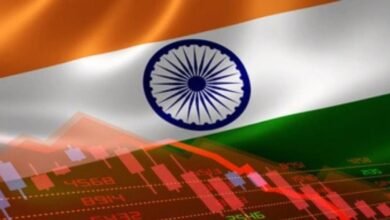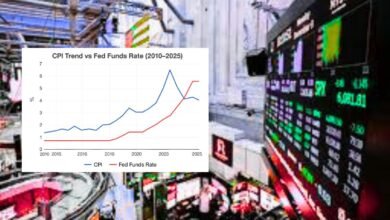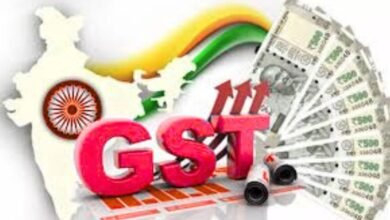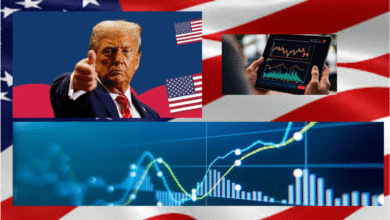A Tale of Two Britains: Inside the FTSE’s Split-Personality Day of Carnage and Conviction
As the FTSE 100 bled a thousand cuts, hope was found in the mid-cap market. An in-depth exploration of the day the London stock market showed the deep and agonising split in the UK economy.
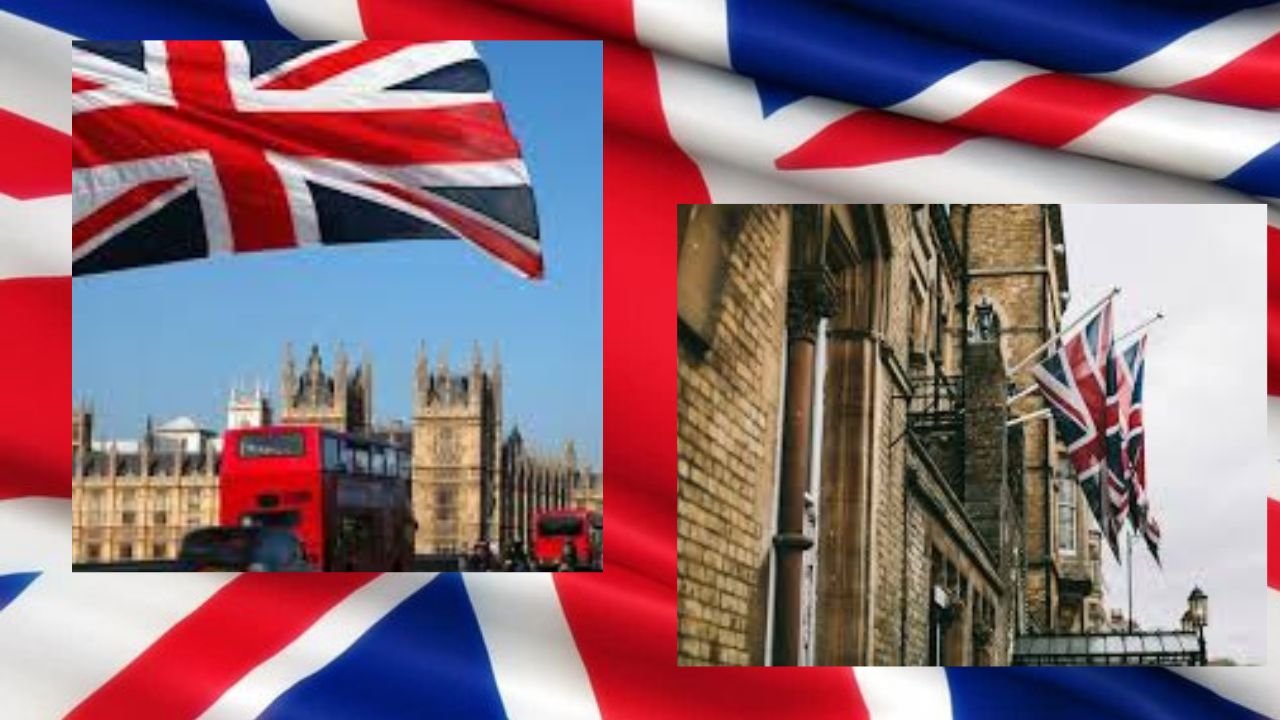
A Market Holding its Breath
There are days at the London Stock Exchange that are like a sanely composed sprint. And then there are days such as today.
It was a day of anxious whispers, of sidelong glances, of a market suspending its breath. On paper, the figures were soothingly tranquil. The blue-chip FTSE 100, Britain’s premier index of the country‘s international goliaths, had fallen a seemingly innocuous 0.2%. But beneath the tranquil surface, a maelstrom of worry was seething.
This was not a gentle dip; it was a gradual bleed from a thousand tiny cuts. It was the narrative of corporate giants faltering, of whole industries shivering in the cold wind blowing in from across the channel, and of a geopolitical storm cloud that was not going to lift. It was a fearful market glued to the clock, awaiting the one institution that was either going to bring relief or more agony: the Bank of England.
And yet, amidst this depression, a strange and potent counter-narrative was being authored. The FTSE 250, the index of Britain’s domestically-oriented companies, was 0.3% higher.
How could this possibly be? How could one part of the market be caving under the weight of external pressures while the other half of the market discovered some reason to rally?
The response is that yesterday, the London Stock Exchange told the story of two Britains. It was a vivid, on–the-hoof picture of a divided economy: one half bound to the rollercoaster fortunes of the world outside, the other discovering islands of resilience and hope on the domestic shores.
Yesterday, we reported the headlines. We will stomp through the ruins of the FTSE 100’s worst performers, from a collapsed ad legend to defense heavyweights targeted by friendly fire. We will sit in the anxious, waiting room of the Bank of England. And we will reveal the shocking tales of corporate bravery that enabled the mid-cap market to resist the gloom. This is the tale of one day which told all about the health of the nation.
Section 1: The Giant’s Stumble – Shattering the FTSE 100’s Day of Sorrow
In order to comprehend the nervousness of the market, you have to tread the war ground of the FTSE 100. The 0.2% decline was not a smooth, gradual fall. It was the aggregate outcome of multiple ferocious, sectoral fights being lost.
1. The German Contagion: A Shiver Down the Channel
The initial shock came not from London but from Düsseldorf. Word that German defense firm Rheinmetall had missed its quarterly targets was like a stone into a calm pond, and the waves crashed hard on Britain’s shores.
The whole aerospace and defense industry, a pillar of the FTSE 100, fell 2.6%. This was not a logical, individual-company response; it was a gut-kick of fear. The reasoning is straightforward and brutal: if a behemoth like Rheinmetall is struggling because of contract delays in Germany, then who knows what’s going on? Are Western defense budgets, increased over the past few years, now encountering bureaucratic bottlenecks or political headwinds?
And this fear metastasized in an instant, toppling Britain’s own heroes:
BAE Systems: Britain‘s leading defense contractor, dropped 4.4%.
Babcock International: Another, fell in lockstep, down 4.5%.
This was old-fashioned sector contagion, a reminder that in a globalized world, a corporate cold in Germany can turn into a flu in an instant in the UK.
2. The Pharmaceutical Squeeze: A Double Dose of Bad News
The medical sector, often an avoid risk in times of doubt, enjoyed no refuge today. It dropped 1.1%, trapped in a agonizing pincer action of internal vulnerability and global threats.
The Micro-Problem: Hikma Pharmaceuticals was the benchmark’s largest loser, dropping 6.7%. Its offense? The humble, mighty, and currently robust Euro. The strength of the currency compelled the firm to reduce its margin guidance for its key injectables division. It was a harsh lesson in the subtle dangers of multinational business, where a treasurer’s source of annoyance can turn into a shareholder’s worst nightmare.
The Macro-Threat: Adding to the industry‘s misery was the shadow of U.S. trade policy looming large. President Trump’s threat of a “small tariff” on pharma imports, with a possibility to escalate to a crippling 250%, loomed large over all pharma stocks. This threat befell titans like AstraZeneca (–1.5%), reminding investors that their intricate, international supply chains are really exposed to the vagaries of politics.
3. The Fall of a Titan: WPP Reaches Rock Bottom
The saddest tale of the day would be that of WPP. The advertising giant, which was once the unchallenged king of its business, watched its stocks drop 2.7% to hit their lowest point since July 2009.
Let that sink in. A 15-year low. This brings the stock back to the dark days shortly after the global financial crisis. The coup de grâce was the company’s move to cut its interim dividend in half.
A dividend reduction is something greater than a budgetary revision; it is a confession of defeat. It’s a message to the marketplace that the company’s faith in its own future cash flows has been shattered to its roots. For WPP, this wasn’t merely a rotten day; it was a bleak milestone in a years-long, agonizing tale of decline, a harbinger of the well-being of global corporate outlays.
Throw in on top of all this the threat of a surging sterling, which increases the cost of all these international companies‘ exports, and the FTSE 100’s picture of gloom is complete. It was a market under attack from all sides.
Section 2: The Elephant in Threadneedle Street – Waiting for the Bank of England
Overhanging every single transaction, every victory, and every defeat was the specter of the Bank of England. The market was on the cusp of the fifth cut in interest rates in 12 months, a prospect that filled investors with a deep sense of uncertainty.
A cut in the rate is an unpalatable pill.
On the one hand, it is a stimulant. It is meant to reduce the cost of borrowing, promote investment, and inject life into a failing economy. It’s the medicine the market seems to want.
On the other hand, the fact that such medicine is needed is a dismal diagnosis. It is a formal recognition by the country‘s top economists that the UK economy is on its knees and in need of assistance.
The actual drama, for veteran investors, lay not in the cut itself, but in the supporting words. Would the Bank stick to its “gradual and cautious” tone? Or would it make a signal of a more bellicose, more hysterical approach? This nuanced change in tone had the potential to alter the entire market mood for the remainder of the year.
This uncertainty immobilized the giants. Why take a big risk when the game’s rules might be rewritten within hours? The FTSE 100’s jumpy, sideways wander was the physical expression of a market gasping in anticipation, expecting some signal from the old lady of Threadneedle Street.
Section 3: The Mid-Cap Miracle – Finding Hope on “Main Street” Britain
And yet, as the world giants of the FTSE 100 struggled with their demons, amazing things were occurring within the mid-cap universe. The FTSE 250, a more representative index of “Main Street” Britain, rose confidently by 0.3%.
This divergence is the most significant tale of the day. The FTSE 250 stocks are, by definition, better sheltered from the global tempests. Less reliant on exports, less sensitive to the vagaries of the U.S. President’s Twitter account, and less sensitive to a strengthening pound, their destinies are more directly related to the state of the domestic UK economy.
And on Friday, there were incredible pockets of homegrown strength shining like beacons in the mist.
Harbour Energy (12.6% higher): The oil and gas producer didn’t merely climb; it went nuclear. A 12.6% rise on the tail of an upgraded annual guidance is a huge vote of confidence. It is a testament to good operational performance and astute management that entirely defied the wider market slumber.
InterContinental Hotels Group (IHG) (up 6.7%): Holiday Inn‘s owner kept on going, rising 6.7% after reporting a rise in first-half profit. It is a strong indication of how the consumer is doing. Even with inflation and economic clouds, individuals are continuing to splash out on experience and travel. It’s a tale of determination that gets lost amid the doom-laden news.
The success of these firms gave a vital psychological spur. It demonstrated that even on a day when fear ruled, there were still remarkable tales of value creation to be found. It was a reminder that the UK economy is not monolithic; behind the struggling global titans, there is a dynamic domestic powerhouse that is still burning brightly.
Conclusion: A Divided Kingdom, A Stock-Picker’s Mandate
This day was not any ordinary trading day. It was a living, real-time diagnosis of the British economy, and what came out was a severe split personality.
The FTSE 100, the face of “Global Britain,” faced outwards and beheld storm on every horizon: trade wars, currency headwinds, and slowing global growth. It was wounded, fearful, and combative.
The FTSE 250, the core of “Domestic Britain,” turned inward and discovered causes for cheer. It discovered islands of operational excellence, consumer solidity, and company confidence that enabled it to hold its head above the sea of despondency.
For the investor, the message of this story of two markets is grim and simple: the era of effortless, passive investing is through. You cannot merely invest in the “market” anymore and hope to prosper. The market is fighting against itself.
Today was a challenge to the stock-picker. It was a plea to move beyond the headline index, to read the individual stories of each firm, and to differentiate between a WPP on its knees and a Harbour Energy rising on wings. In the mad din of a split market, certainty—and chance—are the province of those who work hard.
(Disclaimer: This article is for informational and educational purposes only. It does not constitute financial advice or a recommendation to buy or sell any securities. Please consult with a qualified financial advisor before making any investment decisions.)
